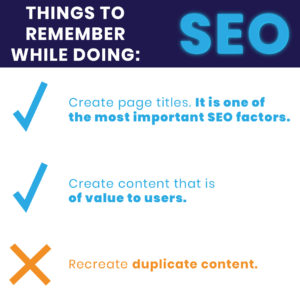The 10 SEO Mistakes To Avoid During Your Next Website Redesign

Unfortunately most designers do not take into consideration SEO variables that impact how your new website will perform after launch.
Redesigning your website can be an exciting opportunity to revamp your brand, enhance user experience, and improve conversion rates. However, if not done carefully, a website redesign can also lead to significant SEO setbacks that can hurt your search engine rankings, organic traffic, and ultimately, your business. To ensure that your redesign project is a success, it’s crucial to avoid common SEO mistakes that can undermine your efforts. Here are the top 10 SEO mistakes to avoid during your next website redesign:
1. Failing to Conduct an SEO Audit Before Redesign
One of the biggest mistakes you can make before redesigning your website is skipping the SEO audit. An SEO audit helps you identify what’s working and what isn’t on your current site. It reveals key data such as which pages drive the most traffic, what keywords you rank for, and where you stand in terms of backlinks and domain authority.
Without this information, you risk losing the SEO value you’ve built over time. Before starting the redesign process, conduct a thorough audit to understand your site’s strengths and weaknesses. This will guide your redesign decisions, ensuring that you retain valuable SEO assets.
2. Ignoring 301 Redirects
When you redesign your website, some URLs will inevitably change. If you don’t implement 301 redirects from the old URLs to the new ones, you risk losing all the SEO value associated with those pages. A 301 redirect tells search engines that a page has permanently moved to a new location, preserving the SEO equity of the old page.
Failing to set up 301 redirects can result in 404 errors, which not only frustrate users but also negatively impact your search rankings. Always create a comprehensive 301 redirect map to ensure a seamless transition for both users and search engines.
3. Neglecting Mobile Optimization
In today’s mobile-first world, optimizing your website for mobile devices is no longer optional—it’s essential. Google has switched to mobile-first indexing, which means that the mobile version of your site is the primary version used for indexing and ranking.
During your redesign, make sure that your site is fully responsive and offers a seamless experience across all devices. This includes optimizing images, improving load times, and ensuring that navigation is intuitive on smaller screens. Neglecting mobile optimization can lead to a significant drop in search rankings and traffic.
4. Overlooking Page Speed
Page speed is a critical factor in both user experience and SEO. Slow-loading pages frustrate users and lead to higher bounce rates, which can negatively impact your search rankings. Google has also made page speed a ranking factor, so it’s essential to optimize your site’s load time during the redesign process.
To improve page speed, optimize images, leverage browser caching, minify CSS and JavaScript, and consider using a content delivery network (CDN). Tools like Google PageSpeed Insights can help you identify areas for improvement.
5. Changing URL Structure Without Consideration
It’s common to want to clean up and organize your site’s URL structure during a redesign. However, making drastic changes to your URLs without considering SEO implications can be disastrous. Search engines and users are accustomed to your current URLs, and changing them can lead to lost rankings and traffic.
If you must change your URL structure, plan it carefully. Ensure that new URLs are SEO-friendly—short, descriptive, and keyword-rich. And, as mentioned earlier, don’t forget to implement 301 redirects to preserve SEO equity.
6. Ignoring Internal Linking Structure
Internal linking plays a crucial role in SEO by helping search engines understand the hierarchy and relationship between pages on your site. During a redesign, it’s easy to overlook the importance of maintaining a strong internal linking structure.
Ensure that your redesign doesn’t inadvertently remove or weaken internal links that are critical for SEO. Review your new site architecture and make sure that your most important pages are easily accessible and well-linked from other relevant pages.
7. Failing to Optimize New Content
A website redesign often involves adding new content or updating existing content. However, if this new content isn’t optimized for search engines, you could miss out on valuable opportunities to improve your rankings.
Ensure that all new content is optimized for relevant keywords, includes meta tags (title, description, headers), and follows SEO best practices. Additionally, avoid duplicate content, which can confuse search engines and dilute your rankings.
8. Not Involving SEO in the Design Process
Design and SEO should go hand in hand, but often, they are treated as separate entities. Failing to involve SEO professionals in the website design process can lead to a site that looks great but performs poorly in search rankings.
Ensure that your design team collaborates with SEO experts throughout the redesign process. This will help you create a site that is not only visually appealing but also optimized for search engines. Key considerations include site structure, navigation, mobile-friendliness, and on-page SEO elements.
9. Overloading on JavaScript and Flash
While JavaScript and Flash can add dynamic elements to your website, they can also pose significant SEO challenges if not used correctly. Search engines have difficulty crawling and indexing content within JavaScript and Flash, which can prevent important content from being discovered.
During your redesign, use JavaScript and Flash sparingly and ensure that all essential content is accessible in HTML format. Consider using modern frameworks that are more SEO-friendly, and always test how search engines are indexing your pages.
10. Skipping Post-Launch SEO Checks
The work doesn’t stop once your redesigned website goes live. It’s crucial to conduct a post-launch SEO audit to identify any issues that may have arisen during the redesign process. This includes checking for broken links, ensuring that 301 redirects are working correctly, and monitoring site performance.
Use tools like Google Search Console to track your site’s indexing status, monitor for crawl errors, and assess any changes in search rankings. Regularly review your site’s analytics to ensure that your redesign is positively impacting your SEO performance.
Conclusion
A website redesign offers a fantastic opportunity to improve both the aesthetics and functionality of your site. However, neglecting SEO considerations can result in a significant loss of traffic, rankings, and revenue. By avoiding these 10 common SEO mistakes, you can ensure that your redesign not only enhances your brand’s visual appeal but also strengthens your search engine presence.
Remember, SEO is an ongoing process, and a successful redesign requires careful planning, collaboration, and post-launch monitoring. Prioritize SEO from the outset to reap the full benefits of your redesigned website. Contact Conversion Pipeline to learn more.
- How To Fix the HTTPS “Not Secure” Message Appearing For Your Website - April 18, 2025
- Why Businesses Skip Chatbots On Their Websites - March 20, 2025
- How Chatbots Boost Website Lead Conversions - March 17, 2025
